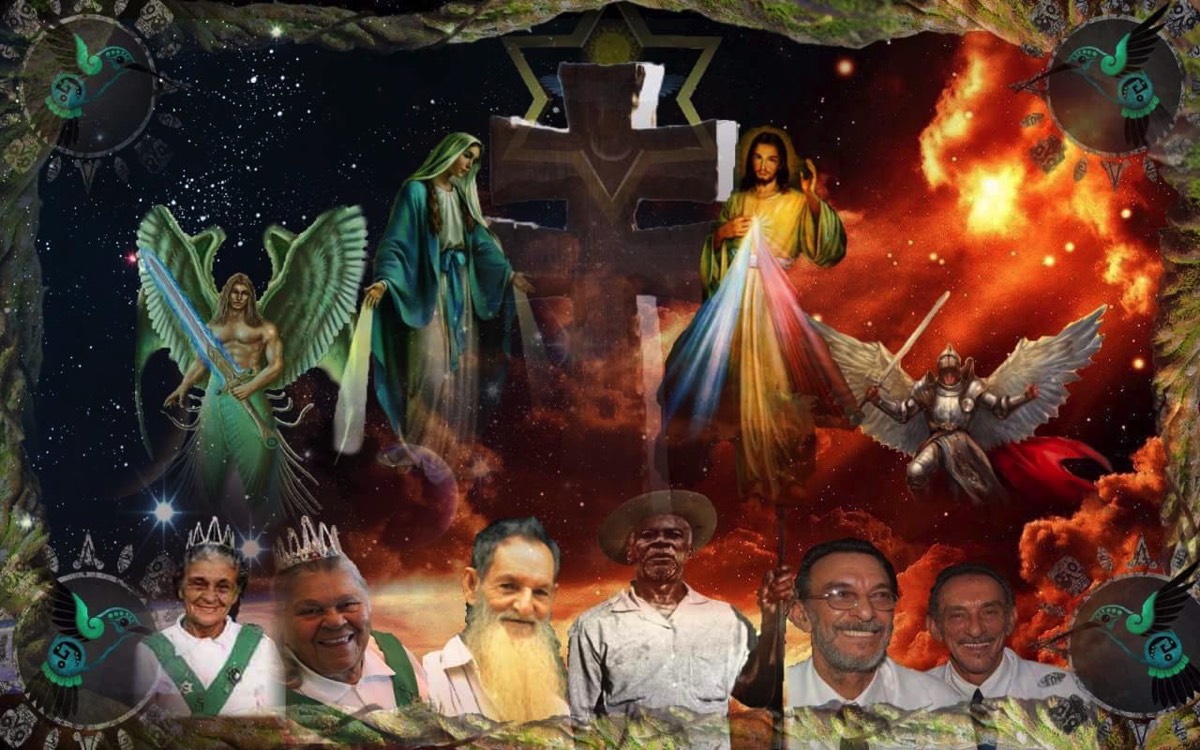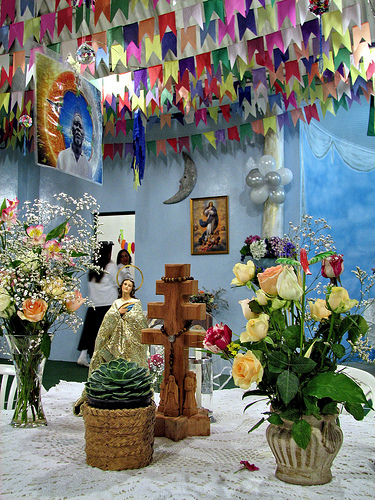
Works of the Santo Daime
A "work" consists in working with the spiritual forces through rituals and offerings to make changes in the human world.
The essential teachings of the Doctrine are transmitted through the hymns, which, when sung, create a direct link to the astral and the Divine. Master Irineu received 129 hymns within his hinario, or hymnal, and his hinario marks his spiritual journey and evolution from when he began drinking the Daime until his death. Through the singing of his hymns, the participant is able to connect with the spirit, teachings, and salvation of the Master and, in many ways, begin walking the same spiritual path which the Master walked.
Hymns are often received as direct transmissions from the astral, and it is through the singing of hymns that teachings of the Master, Padrinhos, and Madrinhas are passed to the members. Through the force of the sacrament, the hymns become living testimony and bring specific energies of healing, strength, communion, forgiveness, and remembrance. Many members of the church receive hymns, and there are literally thousands of hymns throughout the Doctrine.

Santo Daime rituals are known as Works. Centres traditionally have a rectangular or star-shaped central altar, on which stand the Cross of Caravaca, with its double horizontal beam, four candles representing the Sun, the Moon, the Stars and all Divine Beings, photographs of Mestre Irineu and other respected elders of the tradition, and fresh flowers. Each session begins and ends with prayers, mainly adapted Christian prayers. Santo Daime rituals include Concentrations (seated meditation Works), White Works (official, dancing Works), Curas (healing Works) and the Mass. Participants drink Daime in all types of ritual; but the format and focus can differ; concentrations include the singing of hymns with silent, seated meditations, while hymnals involve dancing and singing hymns accompanied by maracas and other instruments. Some Santo Daime Works can last up to 12 hours, and the effects of the Daime combined with dancing, singing and concentration require and develop stamina or ‘firmeza’ – firmness.
Participants in the ritual learn to surrender themselves to the process of the Santo Daime through which they may learn things about themselves, the nature of life and of the Universe. This may include various wonders – the sacrament is known for the visions it generates, and the sense of communion with nature and spiritual reality. The Santo Daime offers an opportunity to align with the Divine. The sacrament facilitates the opening of all levels of being – physical, emotional, mental and spiritual – allowing access to and communion with spiritual energies, guides, healers, and teachers.
The Daime expands consciousness, giving one the opportunity to experience love and truth at depths previously unimagined. Within this space it is possible to sense and feel many things. Some will be very beautiful and some may be painful. The Daime is capable to reveal aspects of both the higher and lower self, sometimes resulting in difficult ‘passages’ involving the integration of dissociated psychological content. The purpose is to use the higher self in order to transform the lower self, for to a certain extent, each is not complete without the other.
One learns to trust that whatever happens is for the highest good, for we cannot transform and heal what we don’t recognize as part of ourselves. It is important to know that, whatever one experiences, one is not alone. There are ‘guardians’ (specially trained church members) available during the Works to assist, and whether or not one is aware of them, spiritual guides and healers present during the ritual.
Participants in the ritual learn to surrender themselves to the process of the Santo Daime through which they may learn things about themselves, the nature of life and of the Universe. This may include various wonders – the sacrament is known for the visions it generates, and the sense of communion with nature and spiritual reality. The Santo Daime offers an opportunity to align with the Divine. The sacrament facilitates the opening of all levels of being – physical, emotional, mental and spiritual – allowing access to and communion with spiritual energies, guides, healers, and teachers.
The Daime expands consciousness, giving one the opportunity to experience love and truth at depths previously unimagined. Within this space it is possible to sense and feel many things. Some will be very beautiful and some may be painful. The Daime is capable to reveal aspects of both the higher and lower self, sometimes resulting in difficult ‘passages’ involving the integration of dissociated psychological content. The purpose is to use the higher self in order to transform the lower self, for to a certain extent, each is not complete without the other.
One learns to trust that whatever happens is for the highest good, for we cannot transform and heal what we don’t recognize as part of ourselves. It is important to know that, whatever one experiences, one is not alone. There are ‘guardians’ (specially trained church members) available during the Works to assist, and whether or not one is aware of them, spiritual guides and healers present during the ritual.
The singing of particular hinarios conicides with official dates on the Santo Daime calender, which includes the singing of the Master’s hinario on the Virgin of Conception (Dec. 7), Christmas, Day of Kings (January 6th), St. John (June 23rd). The hinario of Padrinho Sebastiao is sung on Master Irineu’s birthday (Dec. 15), Saint Sebastian (January 19th), Madrinha Rita’s birthday (June 25), as well as Brazilian Father’s Day. Padrinho Alfredo’s hinario is sung on Padrinho Alfredo’s birthday (January 8), St. Joseph (March 18th), and Saint Peter (June 28th), as well as New Year’s Eve (December 31st).
Non-Portuguese-speaking members often “receive” hymns in their native language.
The hymns of the Santo Daime tradition are organized into books called Hymnals or Hinários. Some collections contain hymns received by one person, while others are collections put together to reflect an intention, such as Healing, Concentration, Mediumship study, or Mass.
Non-Portuguese-speaking members often “receive” hymns in their native language.
The hymns of the Santo Daime tradition are organized into books called Hymnals or Hinários. Some collections contain hymns received by one person, while others are collections put together to reflect an intention, such as Healing, Concentration, Mediumship study, or Mass.
